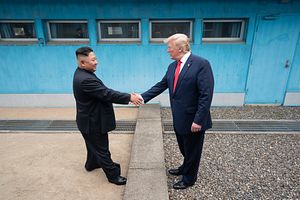Could President Donald Trump and North Korean leader Kim Jong-un shock the world yet again and come together for another summit before the end of the year? While such a question may seem ridiculous given the current state of U.S.-North Korea diplomacy, U.S. and South Korean officials continue to work for the day when negotiations between Washington and Pyongyang resume.
Top-down summitry produces plenty of fireworks, media attention, and feelings among the participants of groundbreaking history being made. But no amount of handshaking between leaders at the top will produce anything substantive for U.S. security interests unless the Trump administration changes its inflexible approach.
Despite three leader-to-leader meetings, numerous letters, and a few follow-up sessions at the working level, there is very little to show for 2-plus years of U.S.-North Korea nuclear diplomacy. The momentum from the 2018 Singapore summit largely stopped in its tracks 8 months later, when Trump and Kim walked away from their second summit in Hanoi without so much as a cursory joint statement. October 2019 was the last time U.S. and North Korean officials were in the same room, and the session broke down after the North Korean delegation walked out over what it described as Washington’s “old stance and attitude.” The U.S. and the North have been communicating through the media ever since, with both sides accusing each other of bad faith and pressing their maximalist objectives.
South Korean President Moon Jae-in, who staked his tenure on establishing a durable peace on the Korean Peninsula, is trying to ensure the diplomatic option remains viable. Speaking at a South Korean-European Union summit on July 2, Moon told the gathering that “South Korea…plans to do its best to make it possible for the North and the U.S. to sit face-to-face again…” Moon’s comments came on the same day the U.S. State Department informed the media of Deputy Secretary of State Stephen Biegun’s July 7 trip to Seoul.
Coupled with Kim Jong-un’s sudden pause of military action plans against South Korea in late June and the possibility of another suspension of joint U.S.-South Korean military drills this August, the perception is that there may be an opening — however small — for talks to resume.
Additional discussions, though, will not be fruitful if the United States and North Korea are unwilling to meet in the middle rather than demand the other capitulate. The North Koreans said as much in their public remarks, making it clear that another summit is not possible so long as Washington offers the same proposal. In Pyongyang’s perception, direct diplomacy with the Trump administration has been an exercise in frustration and a game of showmanship.
The feeling is mutual. North Korean short and medium-range missile tests continue, which sullies the atmosphere for a resumption of dialogue and provides hardliners in Washington with ammunition to argue against concessions of any kind. Pyongyang’s destruction of the inter-Korean liaison office and the cutting of communications lines with South Korea were enormously unhelpful, but indicative of Kim’s anger about the lack of deliverables. The status-quo has trapped the U.S., North Korea, and South Korea in an endless maze, where U.S. and U.N. sanctions are blocking Seoul from improving diplomatic and economic relations with Pyongyang,
However, just because U.S.-North Korea diplomacy has failed thus far does not mean Washington should give up on dialogue. There is still a way to solve this Rubik’s Cube, but solving it will require the Trump administration to drop the far-fetched notion that North Korea’s full denuclearization is critical for peace on the Korean Peninsula.
If the North Koreans have not demonstrated an interest in parting with their nuclear weapons program, it is for a fundamental reason: a nuclear weapons arsenal is the best insurance policy a government can possess. With the U.S. having conducted regime change operations in Iraq, Syria, Iran, and Libya over the past two decades, one can’t blame Kim for keeping his nuclear card close to his chest.
Fortunately, the rationality that prevents Kim from relinquishing his nuclear weapons — regime survival — also prevents him from being reckless with them. The U.S. has exhibited the strength, competency, capacity, and military capability to deter a nuclear North Korea for as long as it needs to do so (many overlook that North Korea became a member of the nuclear weapons club twelve years ago, this October). While a non-nuclear North Korea is certainly ideal, it is not a prerequisite for U.S. national security.
The U.S. does not need to give up on denuclearization as a long-term objective. But neither should it allow denuclearization to circumvent or outright block progress on other issues, including an inter-Korean detente, the signing of a peace treaty to the Korean War, normalizing U.S.-North Korea relations, and creating common-sense military-to-military communication lines between Washington, Pyongyang, and Seoul. These objectives will go a long way towards improving an otherwise adversarial atmosphere in one of the world’s most heavily militarized regions. Coincidentally, each is also a valiant national security accomplishment in its own right.
If the Trump administration goes into any future talks with the North with demands for immediate denuclearization at the top of the list, U.S. officials might as well stay home. It is time to get real: North Korea’s nuclear weapons program is here to stay for the foreseeable future. But the U.S. is more than capable of living with it.
Daniel R. DePetris is a fellow at Defense Priorities and a columnist at the Washington Examiner.
































